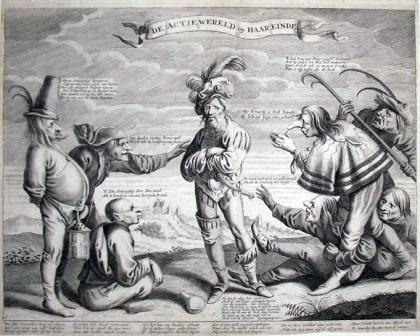Last December 2007, I posted an entry on Het Groote Tafereel der Dwaasheid or The Great Mirror of Folly. Each edition has a slightly different group of prints: Harvard’s copy has 71, Princeton’s 73, and each includes several not in the other volume.
This page, originally engraved by Monogrammist C L, later altered by an anonymous 18th-century Dutch engraver after Pieter Quast (1606-1647) and entitled De Actiewerld op Haar Ende (The End of the Stock-Market World), is included in Harvard’s copy but not Princeton’s. However, we recently acquired an impression to help complete our collection of the prints for in this anonymous 1720 project.
The central figure in this caricature is the philosopher Diogenes (ca. 412-323 BCE). Considered the founder of Cynicism, he eschewed worldly pleasures, wore coarse clothing, and pursued practical good. He is often shown carrying a lantern, searching for an honest person, but in this print his lantern has been given away (presumably having given up finding an honest man). He has lost everything in the stock-market bubble of 1720 from investing in the South Seas Company. As the text beneath the image concludes,
How easily can such a flier be upset by a South Sea blast or a Quinquempoix* bubble! So whoever gives his name and honor for the money, and adores it like an idol, deserves to be scorned in this fashion.
*Quinquempoix was the name of the street where the Parisian money market was located.
This print was first engraved around 1670 by the Monogrammist C L to satirize the tulip mania in the Netherlands. The plate was then altered to satirize the stock-market speculation of 1720.


